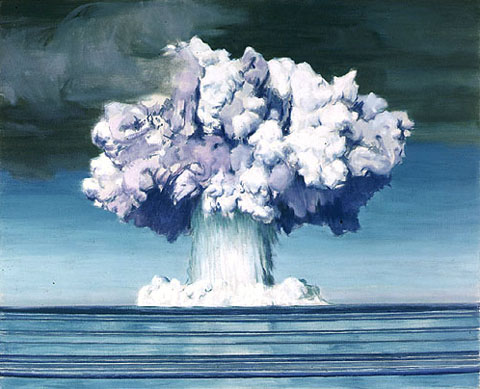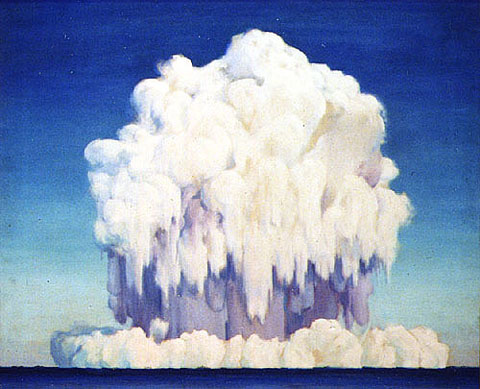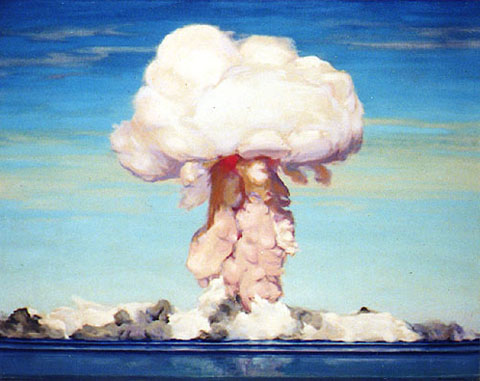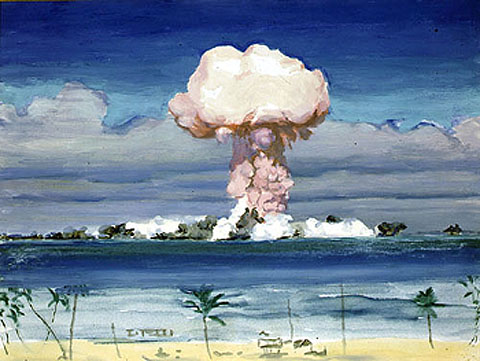[Editor's
Note: Normally these columns are scheduled to appear every other Sunday
in the Kauai Garden Island News.The final published version may vary
from this text as TGI retains the right to correct and edit
the material. The copyright to the published version is held by TGI
owner Kauai Publishing. Some material in TGI columns may have appeared
on www.islandbreath.org already]
Island Breath: The Hawaii Range Complex
by Juan Wilson on 3 September 2007 Revision 5.0 070905

The Forces of Life and Death
Look around. Check the beaches for shells. Take a close look at the
reefs. Talk to commercial fishermen. If you have been reading accounts
on planetary health you probably know it already. The oceans are dying.
It is a big deal not only for us in Hawaii, but for all life on earth.
Over the last generation, almost 90% of the large food fish have been
strip-mined from the seas. Vast tracks of the ocean north of Hawaii are
clogged with floating plastic garbage from the mainland USA and Asia.
Even a minor rise in ocean temperature will devastate what is left of
the planets delicate reef systems.
The US Navy is the most powerful instrument of destruction in the
world. In the face of the collapse of the world economy in the coming
energy crisis; in the face of the emerging disaster of chaotic climate
change; in the face of the overburdening of the planet's capacity to
sustain our numbers... shouldn't the Navy reassign its priorities?
Instead of adding to its burdens, shouldn't the Navy make whatever
attempt it can do save the world's oceans? That our senior naval
personnel could propose expanding the death and destruction of life on
this planet, at this critical time, hardly seems credible. Don't they
not know what is at stake?
The real enemy is not a potential ballistic missile 2000 miles
downrange, it is the death of the planet. It is time for the Navy to
cease and desist its deadly operations in the Pacific. Stop trying to
turn Hawaii into Mordor. Instead, take this Draft EIS and head back to
San Diego and Washington DC. Face the real enemy! Go back to the
drawing boards and come up with a new strategy that responds to our
actual predicament and addresses the real foundations of global
security - support and restore ocean vitality. Address our future and
stop shadow boxing with fears and phantoms of the past. Our lives
depend on it.

Three Islands and an Imperial Navy
Ecologically, we are past a turning point. There are fewer options
before us and little tolerance for bad judgment. We have to get plans
right this time because there won't be another. This applies to the
Navy's proposed plans for the future of Hawaii. To date, the Navy has
had an abysmal history regarding the treatment of islands throughout
the world's oceans. And we are talking about the treatment of our
allies, not our enemies.
1) BIKINI ISLAND:
After World War Two the native Micronesian population was removed from
the islands of Bikini Atoll by the Navy. Between 1946 and 1958, as part
of the Pacific Proving Grounds, the islands of the atoll were the site
of more than twenty nuclear weapons tests. Beginning in 1952 the tests
included the atmospheric and submersed detonation of hydrogen bombs. In
1968 the US Navy declared Bikini Island habitable and started bringing
Bikinians back to their homes. In 1978, however, the islanders had to
be removed again when strontium-90 in their bodies reached life
threatening levels. The failed attempted cleanups have cost hundred of
millions of dollars.
2) VIEQUES ISLAND:
During
World War II, the Navy purchased about two thirds of Vieques Island (a
part of the territory of Puerto Pico). Many residents, who had no title
to the land they occupied, were evicted. After the war, the Navy used
Vieques as a firing range and testing ground for bombs, missiles, and
other weapons. It was the most important Atlantic Ocean range facility
for the US and NATO. The continuing post-war "occupation" drew protests
from the local community angry about environmental impact of weapons
testing. Protests came to a head in 1999 when island native was killed
by a bomb dropped during a target practice. A campaign of civil
disobedience began. As a result, in 2003, the Navy reluctantly withdrew
from Vieques.
3) KAHOOLAWE ISLAND:
Here in Hawaii we have faced military occupations as well. After the
attack on Pearl Harbor, the U.S. Army declared martial law throughout
Hawaii and took control of Kahoolawe Island. For six decades, under
Navy oversight, thousands of tons of ordinance bombarded the island in
training exercises. In 1994, after decades of pressure from Hawaiian
groups, the Navy agreed to transfer title of Kahoolawe to the State of
Hawaii. Although the Navy spent $400 million and ten years on a a
required cleanup, uncounted unexploded bombs and shells still remain on
the island. Many items have washed down gullies and still others lie
underwater offshore. The Navy turnover was completed in 2003, but the
cleanup was never finished, leaving Kahoolawe a deadly and toxic
landscape to this day.

Kauai and Hawaii Range Complex
As part of the world's only "Super Power", the Hawaiian Islands are the
strategic center of US military operations in the Pacific Ocean. Hawaii
is the command and control hub for an area covering almost half of the
world. Pearl Harbor may be the center of attention, but Kauai island
plays an important role as the command backup for Pearl and as the
tracking, sensing and communication coordinator for activity throughout
the Pacific Ocean. On Kauai, the nerve center is the Pacific Missile
Range Facility (PMRF) and it is crucial to the operation of the Navy's
Hawaii Range Complex (HRC) covering over two-and-a-half million square
miles.
The Navy is proposing a major upgrading and expansion of the Hawaii
Range Complex. This is in order to do more research, development,
testing and evaluation (RDT&E) of military systems and weapons. The
HRC is the largest and most elaborate weapons range in the world, and
we are at the center of it.
The range extends past Midway and includes all of Hawaii and the
Northwest Islands. To get approval for the range expansion the Navy has
to estimate how much damage they will cause the environment and
demonstrate what efforts they will make to reduce that damage to
"acceptable" levels. In July they published the Draft Environmental
Impact Statement for public review and comment. It comprises three
volumes as big as Honolulu phonebooks. You can read portions of the EIS
as PDFs online at: http://www.govsupport.us/navynepahawaii/EIS.aspx
The deadline for your comments is 17 September 2007. Comments can be sent to:
Commander of the Pacific Range PMRF
PO Box 120, Kekaha, HI, 96752-0128
With the upgraded range the Navy has planned over one-hundred-and-forty
RDT&E projects. Many are for the development of new weapons systems
like Antisubmarine Warfare, Advanced Hypersonic Weapons, Missile
Defense, Electronic Warfare and Directed Energy Lasers.
Many of these programs will be run from the PMRF. Three that are of great concern to me.
1) MID-FREQUENCY SONAR
The Navy says that the increased tempo and frequency of training
operations includes as many as five-thousand hours of mid-frequency
active tactical sonar and the associated DICASS sonobuoy, MK-48
torpedo, and dipping sonar. Underwater detonations are possible during
several programs. All this will destroy uncountable numbers fish and
sea mammals. There is little mitigation that can be done when these
systems are used.
2) EXPEDITIONARY ASSAULT ACTIVITIES
In its EIS the Navy says that before Expeditionary Assault Activities
landing routes and beach areas will be surveyed for the presence of
sensitive wildlife. An exercise will be halted if marine mammals are
detected on the target area. The operation will foster the
reestablishment of native vegetation. What it really sounds like the
Expeditionary Assault will tear up the beaches and dunes between Poli
Hale and Barking Sands. This is literally an assault directly on Kauai.
3) DIRECTED ENERGY LASER WEAPONS
Worse is the Directed Energy Laser Weapons Program. These are chemical
lasers in which use hydrogen fluoride, a corrosive material which can
be made to release a powerful burst of infrared radiation. The laser
can be focused and aimed as a weapon (death ray). These laser can
generate least 25 megawatts of energy that could destroy a missile
2,000 miles away. For the scale of this realize 25megawatts is
half the electrical power generating capacity of Kauai. The firing of
this weapon also destroys the lasing device and contaminates its site
with hydrogen fluoride. A thousand foot radius danger zone, that could
close the state park, will persist for days.
The Navy has not told us what effect on the environment hydrogen
fluoride waste will have. What if there is a heavy rain and runoff
after a test? What effect on coral reefs and offshore marine life would
there be from hydrogen fluoride contaminated runoff into the
ocean? What efforts will guarantee the safety of people using the
access road to Poli Hale State Park after a test?
In its Navy's EIS executive summary it simply says, "Appropriate
remedial procedures would be taken before initiation of potentially
hazardous laser operations on PMRF".
That's it?!! That is unacceptable.
|




